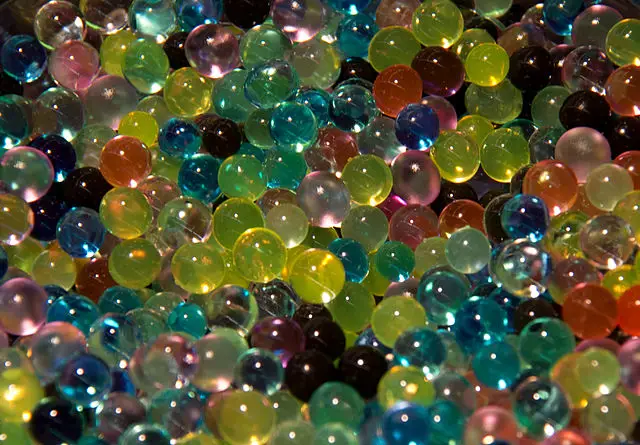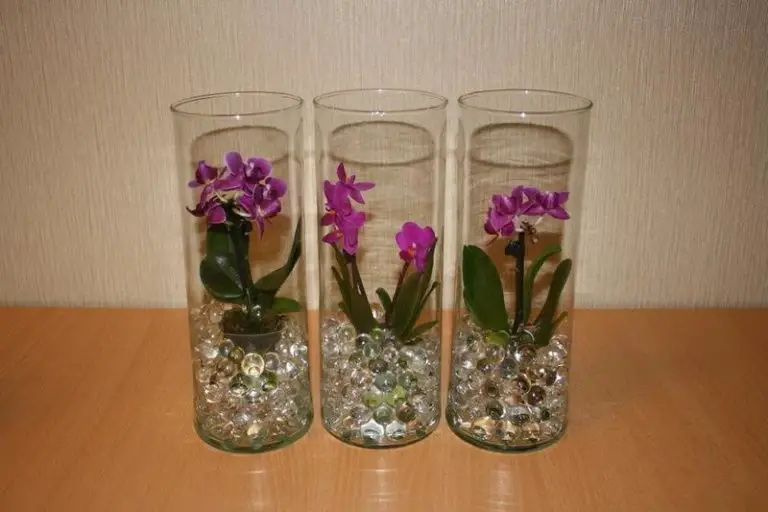 I came across an article about growing orchids in water beads. It piqued my interest, so I decided to do some more research on it.
I came across an article about growing orchids in water beads. It piqued my interest, so I decided to do some more research on it.
What Are Water Beads?
Water beads are small, water-filled beads. They are often used as a decoration for cut flowers in vases.
Florists use them because flowers in water beads last longer than those in water.
Water beads are usually made of a water-absorbent polymer, such as polyacrylamide.
They come in all shapes, colors, and sizes but most orchid growers seem to be using the clear ones.
Some are also made with natural ingredients using tapioca.
When the beads are exposed to water, they swell up. Water beads can also be used to help plants with moisture retention.
When placed around the base of a plant, the beads will absorb water and release it gradually over time, keeping the plant hydrated.
Water beads can be an easy and attractive way to add moisture to your indoor plants.
Also called water pearls, gel water beads, or hydrogel beads. These acrylic beads are often clear, although some are colored too.
They absorb water and then slowly release it over time, providing a constant source of moisture for your plants.
As they dry they start to shrink but they come back to full size when more water is added.
Water beads can be beneficial for growing vegetables and plants indoors, as they help to regulate the moisture levels in the soil.
They can also help to reduce the number of times you need to water your plants.
To use water beads, simply place them in a bowl or container and add water. Then, transfer the beads to your plant’s potting soil.
While I know people use them successfully with houseplants that does not mean they are good to use for orchids.
Water Beads For Orchids?

Orchids can be finicky plants especially when it comes to watering. After all, they prefer growing on trees and most are epiphytes.
So it is no surprise orchid growers are looking to find easier and better ways to water their orchids.
Many orchids are killed each year by over or under watering so are gel beads the answer?
They certainly look pretty in a glass vase so I can see why folks would use them just for appearance’s sake.
So while orchids prefer high humidity they don’t like having their roots wet without some drying time too.
Water Beads Pros And Cons
As I did my research I discovered water beads had both pros and cons.
Some folks say they worked great and some said they will eventually kill your orchids.
As usual, the internet can be full of contradictory information. After all, there are people online who will swear to you the earth is flat.
So I found a video that does a good job of explaining why you shouldn’t be growing orchids in water beads.
I think the advice in the video is spot on you can check out her website https://orchideria.com for great info on growing orchids.
I personally don’t think I would use them. At least not by filling up an orchid plant in a jar full of them.
They might be useful as a bottom layer for water culture but why not just use water?
Pros: Are Water Beads Good For Orchids?
Water beads are a type of water-retaining polymer that can be used to water plants.
When placed in water, the beads swell up and store water inside their gel-like structure.
This water can then be slowly released over time, providing a steady supply of moisture for plants.
Water beads are often used for plants that require high levels of humidity, such as orchids.
Water beads do have a lower pH which is in the range orchids prefer and they can also hold nutrients to feed the roots.
Since they are clear or semi-transparent they allow light to get at the lower roots and keep them green.
Orchids are tropical plants that need high humidity to thrive. However, they also require good drainage to prevent root rot.
Water beads can help provide the perfect balance of moisture for orchids by slowly releasing water into the vase without waterlogging the roots.
As a result, water beads can be a helpful addition to an orchid care routine.
Cons: Why Are Water Beads Bad For Orchids?
If you’re an orchid lover, you’ve probably heard of water beads.
These small, round beads are often used as an attractive way to water plants, as they help to evenly distribute water and prevent waterlogging.
However, water beads can actually be harmful to orchids.
The beads can block airflow to the roots of the plant, preventing it from breathing.
Most of the orchids we grow are epiphytes. They grow on trees and their roots get nutrients from the air.
Even though they are rained on frequently they are exposed to open air and breezes and so they dry quickly.
So the addition of water beads can encourage fungal growth, which can lead to diseases like root rot.
In addition, as they start to dry they shrink. This can move the roots and possibly break some.
Orchids also don’t like having their roots disturbed.
For these reasons, it’s best to avoid using water beads when watering your orchids.
Water Beads For Terrestrial Orchids
I think water beads have potential though. Most people were using just water beads to pot up their orchids.
I don’t think I would use them that way for epiphytic orchids. But using them as part of a potting mix might have potential.
Terrestrial orchids might do well in a potting mix with orchid beads in it. I also think they can be used with other house plants.
But I found people who tried them with cacti or succulents had bad results.
Final Thoughts On Growing Orchids In Water Beads
I think using water beads has potential. I am a grower who likes to try new things so I could see myself trying them.
I would not fill all around the orchid’s roots with them and I would keep an eye out for signs of rot.
I would be more likely to place them in the bottom of a vase and set my orchid on top of them. So they may be useful for water culture that way.
I would probably use them as part of a traditional potting mix and see how my orchids reacted.
The problem with that is not being able to see the roots. And it doesn’t take advantage of their transparency.
You could try them out on more conventional houseplants and they might work very well for that.
Orchids need high humidity but they don’t like their roots to be continually wet so I am skeptical about growing orchids in them.
If you have an orchid that you are not attached to you could give growing orchids in water beads a try. It might work for you.
I think experimentation can be a good thing and even if an experiment fails you can still learn things from it.
So at this point, the jury is out on whether growing orchids in water beads is a good idea and it’s up to you to see if they will work in your growing environment.
Read more: Growing Orchids In Hydroponics: Tips and Tricks
This post contains affiliate links.

